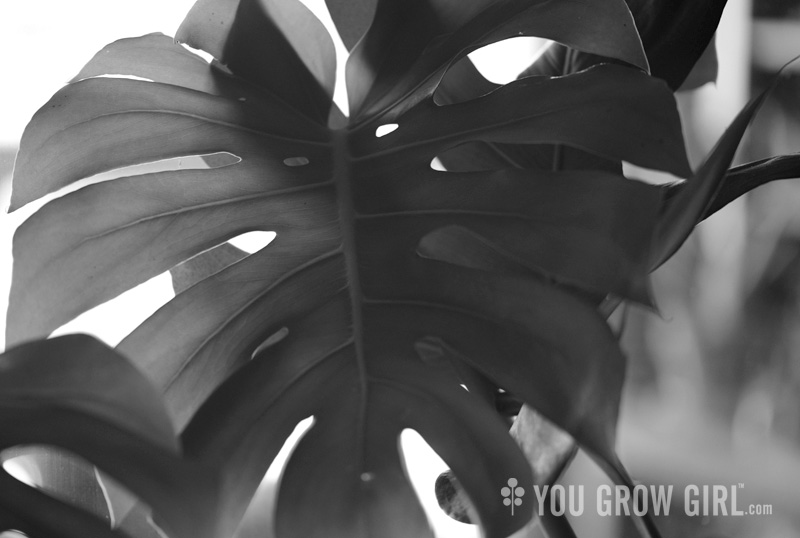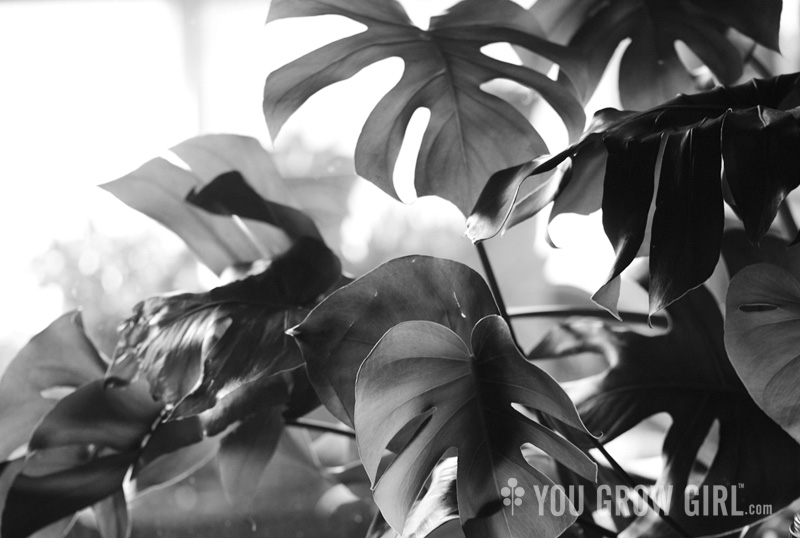
I recently joined the legions and brought home a Monstera deliciosa aka Swiss cheese plant. I wrote off the idea of getting one long ago due to a lack of space with appropriate growing conditions. However, we removed the living room TV this summer and that has opened up space around a south-facing window that doesn’t have the intensity of a south-facing window as it is sat several feet behind a covered porch. Rather than being direct light, it is more of a bright, but indirect light, ideal for a range of tropicals. We are quickly taking advantage and filling… or I should say I am filling, that space with plants.
When it comes to plants, I move fast.
Once some of my older plants come inside for the winter, that window will be completely stuffed. I’m going to add a humidifer and perhaps I will be able to stop struggling through the dry months with some of the other tropicals I keep such as a bodhi tree (Ficus religiosa) that always comes down with a case of The Spider Mites every winter, the poor thing just barely hanging on like that 80s office motivational poster of a kitten on a tree limb, HANG IN THERE BABY!, until it is warm enough to be put outside where it immediately springs back to life. And then the same cycle repeats in 6-8 months. But everything is going to be different this winter, friends, because there will be a humidifier aimed right at them! I am optimistic, while also quietly preparing for mayhem.

Back to the Monstera. She was a magnificent beast. We contemplated calling a cab, but Davin was able to carry her on the streetcar and walk her the rest of the way home in an over-sized shopping bag that I’d brought in preparation, because when it comes to plants, I have taken the motto of the Boy Scouts to heart: Be prepared. The bag worked like a charm to keep the many arms of the plant from grabbing onto doorways, people, and objects on public transport and no stems or leaves were damaged as a result. Living in the city, you see all sorts on public transportation and the bar was set pretty high when I once saw a guy on a regular city bus struggling to prop up a kid-size mattress. I generally don’t like to put people out, but from that point on, it felt as though anything less than a mattress is nothing not worrying about.
The next morning I was like a kid waiting for Christmas, eager to get to that plant. It was no easy feat, but with help I managed to remove the wedged-in and root bound plant from its pot. I could have cut the pot open, but I hate the idea of wasting a big hunk of plastic destined for the landfill. I carefully teased the tangled roots apart to discover there were 10 plants in the pot: 2 large, 2 slightly smaller, 3 juveniles (fenestration aka holes in the leaves, just starting), and 3 babies! I divided the largest and the smallest up into 2 big pots, and planted the juveniles into their own smaller pots just because I love the look of them when they are a few simple leaves. My brother has already elected to take one.
The two biggest Monsteras have been in the living room window for a few weeks now, where I hope they will survive the winter and many more to come.

Growing Monstera Deliciosa
Monstera is a very large-leaved, epiphytic plant that climbs up trees in search of light in humid, tropical rainforests of Mexico and south America. The ripe fruit, while next to impossible to attain when grown indoors, is edible and many people compare it to pineapple.
- Bright to medium/low light: Needs depend on maturity of the plants with babies tolerating more shade than, large, mature leaves.
- Plants that aren’t growing tend to need more light OR require a moss/coir pole to grow on as this plant’s natural tendency is to climb and vine. Lack of light also leads to stunted growth and less holes in the leaves aka fenestration.
- Prefers soil that is on the moist side, but never soggy. Water more often during the active growing season, and allow the top few inches to dry out between applications, especially with larger, more established plants.
- Humidity: Mist regularly if your home is very dry or employ a humidifier nearby.
- Pot in rich, but very well-draining. Mix potting soil with lots of chunky bark or coir,and/or perlite, as much as 2:1 or even 1:1. Err on the side of more organic matter if you tend towards under watering your plants.
- Fertilize every month, only through the growing season. I use sea kelp and fish emulsion, as well as vermicompost mixed into the soil at potting time or add 1 tablespoon or so on top of the soil.
- Watch out for spider mites and thrips during the winter months.
- Propagate during the growing season by taking a stem cutting just after a node. The cutting should include at least one leaf.
Wow you really got a lot of extras out of that one purchase! I’d be so thrilled.
It was a good deal!
I love at the end how you discuss how you care for this plant. Its a cool story mixed with some very useful information.
I have been wanting to get a Monstera Deliciosa myself, but wasn’t sure how to care for it. I look forward to coming back to your website in the future.
@Sarah: I find Monsteras to be fairly forgiving plants. I somehow by now have three huge ones that make my husband mumble things about machetes at times. Do give them a pole to climb on (alternatively, a hook in the ceiling with a ribbon to tie up the plants works as well) and you’re good.
Is this not a split leaf Philodendron?
Same thing. Just a different common name.